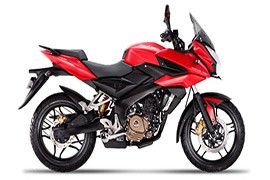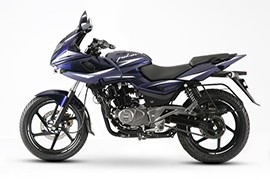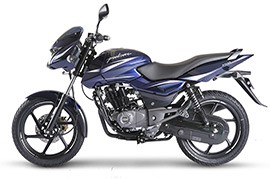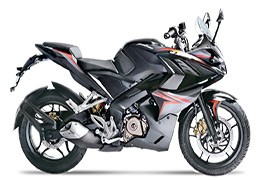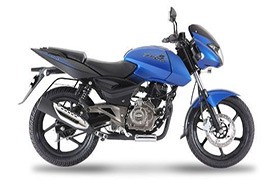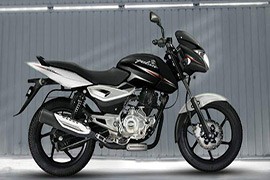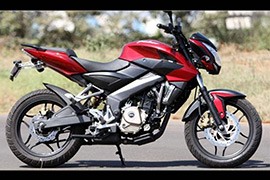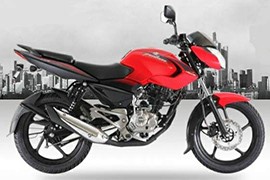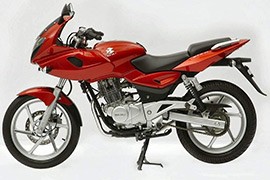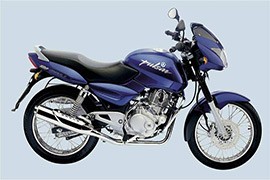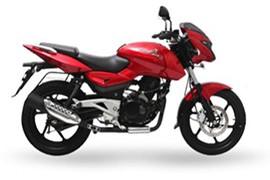BAJAJ PULSAR Models/Series Timeline, Specifications & Photos
First production year: 2005
In 2015, Bajaj introduced the Bajaj Pulsar AS 200 alongside the AS 150 and RS 200 models. The AS designation stood for "Adventure Sport," while the RS designation stood for "Race Sport." The AS series packed a semi-fairing with projector headlamps, which were common among them all.
The Pulsar AS200 had the same 199cc single-cylinder liquid-cooled engine as the Pulsar RS 200 model except for the fuel injection system. The AS 200 was based on the 200NS platform, while the smaller 150cc version was built on a new perimeter frame.
In 2017, the Indian motorcycle maker released the Bajaj Pulsar AS 200, a powerful machine that brought an unmatched adventurous spirit due to its design and engineering. It was a small displacement motorcycle with an aggressive appearance.
Its visual department was characterized by standard features, such as a semi-fairing with a single headlight unit, a small windscreen, a two-piece dual seat with passenger grab handles, a side stand, and ten-spoke alloy wheels.
In the performance department, the 2017 Bajaj Pulsar AS 200 had installed a 199cc four-stroke liquid-cooled single-cylinder engine underneath its fuel tank, delivering an output power of 24 hp with maximum strength at 9,500 rpm and 18 Nm (13 lb-ft) torque.
The rear wheel was set in motion by a six-speed manual transmission that took the power from the engine and sent it to the rear via a final chain drive.
In 2017, the Indian motorcycle maker released the Bajaj Pulsar AS 150, a small displacement motorcycle that debuted in 2015 alongside the RS 200 and AS1200. The AS designation stood for Adventure Sport.
The Bajaj Pulsar was a range of motorcycles manufactured by Bajaj Auto in India. The bike was developed by Bajaj's product engineering division in association with Tokyo R&D and later with motorcycle designer Glynn Kerr.
Visually, the bike had standard fittings, such as a half fairing with a single headlight unit, a small windscreen, a two-piece dual seat with passenger grab rails, a side stand, a dual-sided swingarm, and 10-spoke alloy wheels.
For suspension, the bike packed a telescopic fork with anti-friction bushes on the front and a Nitrox single shock absorber on the rear, offering optimum suspension performance and handling capabilities.
As for the braking power, the bike's wheels were fitted with a front and rear petal brake disc engaged by hydraulic floating calipers, delivering optimum stopping power.
In the performance department, the 2017 Bajaj Pulsar AS 150 had installed a 149cc air-cooled single-cylinder engine mounted underneath the fuel tank, boasting 17 hp with a peak force at 9,500 rpm and 14 Nm (10 lb-ft) torque at 7,000 rpm.
The power generated by the powerhouse was sent to the rear wheel through a five-speed transmission and a final chain drive.
In 2017, the Indian motorcycle maker released the Bajaj Pulsar 250F, a fast and agile motorcycle similar to its siblings. The bike was created for the youngest among Bajaj's fans and for the more seasoned ones.
In 2010, the maker released a naked version of the base Pulsar 220 named Pulsar 220S (Streetfighter), which retained everything from the base model except the fairing. The Fairing was similar to the one of the Pulsar 180 and 150 models. Eventually, the Pulsar 220S was renamed as the Pulsar 220F.
In 2011, the bike came with new color options, while in 2017, it received a BS4-compliant engine, an Always Headlamp On (AHO), a new laser-edge color scheme, new graphics on the digital display with a blue backlight, and several mechanical changes.
The bike's visual department was characterized by standard fittings, like a half fairing with a medium-sized windscreen, a two-piece dual seat with passenger grab rails, a single exhaust system with a silencer mounted on the right-hand side, and six-spoke alloy wheels.
In the performance department, the 2017 Bajaj Pulsar 220F had its heartbeat set by a 220cc four-stroke single-cylinder oil-cooled engine that delivered 22 hp with a peak force at 8,500 rpm and 19 Nm (14 lb-ft) at 7,000 rpm.
As for the braking power, the bike's wheels were fitted with a 260 mm brake disc on the front and a 230 mm brake disc on the rear, both coupled to hydraulic calipers.
In 2017, the Indian motorcycle manufacturer released the Bajaj Pulsar 150, a small-displacement motorcycle part of the Pulsar family. The 2017 model came with several modifications, including a BS4-compliant engine, Always Headlamp On (AHO), a new laser-edge color scheme, new graphics on the digital display with a blue backlight, and several mechanical changes.
The Bajaj Pulsar was a range of motorcycles manufactured by Bajaj Auto in India. The bike was developed by Bajaj's product engineering division in association with Tokyo R&D and later with motorcycle designer Glynn Kerr.
The bike's visual department was characterized by standard features, such as a single headlight unit integrated into a small cowl, a small windscreen, a one-piece dual seat with a pillion grab rail, a dual-sided swingarm, and six-spoke alloy wheels.
The bike's front end was controlled by a 31 mm telescopic fork with anti-friction bushes and a 240 mm brake disc with a hydraulic caliper. In contrast, the rear end was handled by a 130 mm drum braking unit and dual shocks.
As for power, the 2017 Bajaj Pulsar 150 had installed a 149cc four-stroke single-cylinder air-cooled engine underneath its fuel tank, boasting 11 hp with a peak force at 9,000 rpm and 12 Nm (9 lb-ft) torque at 6,500 rpm.
The power was handled by a five-speed manual transmission with a wet multi-plate clutch that sent power to the rear wheel through a final chain drive.
The all new Bajaj Pulsar RS200 is built on the lineage of Pulsars and takes it way ahead, of not only its competition but ahead of any Pulsar that has seen daylight. Pulsar RS 200 is unstoppable when it comes to performance. Its 6 speed gearbox takes acceleration to a whole new level, with its unique responsive shifting.
The Bajaj Pulsar was a range of motorcycles manufactured by Bajaj Auto in India. The bike was developed by Bajaj's product engineering division in association with Tokyo R&D and later with motorcycle designer Glynn Kerr.
In 2014, the Indian motorcycle maker released the Bajaj Pulsar 180 DTS-i, a small displacement motorcycle part of the Pulsar family. The 2014 model was similar in design to its siblings, packing several differences, including the engine.
Aesthetically, the bike packed standard fittings, like a single headlight unit integrated into a small cowl with a small wind deflector, a two-piece dual seat with passenger grab handles, a right-hand side-mounted shock absorber, and six-spoke alloy wheels.
The bike was built around a double-cradle steel frame with a telescopic fork on the front and a five-way adjustable gas-charged Nitrox shock absorber on the rear, providing optimum suspension performance and handling.
As for the power figures, the 2014 Bajaj Pulsar 180 DTS-i had its soul brought to life by a 179cc four-stroke air-cooled single-cylinder engine that delivered an output power of 23 hp with maximum strength at 8,500 rpm and 14 Nm (10 lb-ft) torque at 6,500 rpm.
The power generated by the engine was sent to the rear via a five-speed transmission and a final chain drive, pushing the motorcycle to a top speed of 122 kph (76 mph).
In 2014, the Indian motorcycle maker released the Bajaj Pulsar 150, a small displacement motorcycle part of the standard and Mini Sport series. It debuted in 2001 and succeeded after the Indian Army ordered many of its units.
The Bajaj Pulsar was a range of motorcycles manufactured by Bajaj Auto in India. The bike was developed by Bajaj's product engineering division in association with Tokyo R&D and later with motorcycle designer Glynn Kerr.
The bike was produced between 2001 and the present (2024) and was part of the standard and Mini Sport series. It was available in several displacements, including 125, 135, 150, 160, 180, 200, 220, and 250cc.
The 2014 model had standard fittings, like a single headlight unit integrated into a small cowl with a wind deflector, a one-piece dual seat with a passenger grab rail, a side-mounted shock absorber, a single exhaust system mounted on the right-hand side, and five-spoke alloy wheels.
In the performance department, the 2014 Bajaj Pulsar 150 had installed a 149cc four-stroke single-cylinder air-cooled engine underneath its fuel tank, boasting 11 hp with a peak force at 9,000 rpm and 12 Nm (9 lb-ft) torque at 6,500 rpm.
The braking power was achieved by a 240 mm brake disc mounted on the front wheel engaged by a hydraulic caliper and a 130 mm drum braking unit on the rear wheel.
The Bajaj Pulsar NS200, previously known as the Bajaja Pulsar 200NS, was a sports bike made by Bajaj from 2012 until the present (2024). The NS designation stands for Naked Sports.
In 2012, the Indian motorcycle maker introduced the Bajaj Pulsar NS200, a streetfighter machine powered by a small displacement engine that could send the bike to a top speed of 140 kph (87 mph).
The 2012 machine was available with a dual-channel Anti-Lock Braking System (ABS), an inverted fork on the front, and two new colors, white and black. The white color scheme was the most popular among young riders.
The bike's aesthetic department was characterized by standard features, such as a single headlight integrated into a small cowl, a two-piece dual seat with passenger grab rails, a dual-sided swingarm, a side stand, and 10-spoke lightweight alloy wheels.
The bike was built around a pressed steel perimeter frame with a 37 mm telescopic fork on the front and a Nitrox monoshock with a piggyback canister on the rear, offering optimum suspension performance and handling capabilities.
In the performance department, the 2012 Bajaj Pulsar NS200 had its heartbeat set by a 199cc four-stroke single-cylinder air-cooled engine that delivered an output power of 24 hp at 9,500 rpm and 18 Nm (13 lb-ft) torque at 8,000 rpm.
In 2012, the Indian motorcycle maker released the Bajaj Pulsar 135 LS, a small displacement motorcycle part of the Pulsar family. The bike had great reviews from owners, stating that it has smooth ride quality and handling, great fuel economy, and many more positive thoughts.
The Bajaj Pulsar was a range of motorcycles manufactured by Bajaj Auto in India. The bike was developed by Bajaj's product engineering division in association with Tokyo R&D and later with motorcycle designer Glynn Kerr.
It was made between 2001 and the present (2024) and was available in several displacement engines, like 125, 135, 150, 160, 180, 200, 220, and 250cc.
Visually, the 2012 Pulsar 135 LS had an aggressive design with standard features, such as a small front cowl with a single headlight, a small wind deflector, a two-piece dual seat with a passenger grab handle, a single exhaust system with a silencer mounted on the right-hand side, and five-spoke alloy wheels.
As for the power figures, the 2012 Bajaj Pulsar 135 LS had installed a 135cc four-stroke air-cooled single-cylinder engine underneath the fuel tank, delivering an output power of 14 hp with a peak force at 9,000 rpm and 11 Nm (8 lb-ft) torque at 7,500 rpm.
The bike's front end was controlled by a telescopic fork with anti-friction bushings and a 240 mm brake disc, while the rear end was handled by a five-way adjustable Nitrox shock absorber and a 130 mm drum braking unit.
In 2008, the Indian motorcycle manufacturer released the Bajaj Pulsar 200 DTS-i, a 200cc model with a new oil cooler, which helped control the engine oil temperatures at higher speeds and rpm.
In addition to the oil cooler, the bike's visual department differed from previous models, packing a redesigned front fairing, a two-piece dual seat instead of the previous single piece, and two passenger grab rails.
It was equipped with standard features, such as a half fairing with a small windscreen, a two-piece dual seat with side-mounted pillion grab handles, a single side-mounted shock absorber, a center stand, and six-spoke aluminum alloy wheels.
For suspension, the motorcycle packed a telescopic fork on the front and a dual-sided swingarm with a left-hand side-mounted shock absorber, providing optimum suspension performance and handling capabilities.
As for the braking power, the bike's wheels were fitted with a 260 mm brake disc on the front and a 230 mm brake disc on the rear, engaged by hydraulic calipers, offering optimum stopping power.
The 2008 Bajaj Pulsar 200 DTS-i had its heartbeat set by a 219cc four-stroke single-cylinder oil-cooled engine, fed by a carburetor, delivering an output power of 21 hp and 19 Nm (14 lb-ft) torque.
The power generated by the engine was transferred to the rear axle via a five-speed gearbox controlled by a wet multi-plate clutch and a final chain drive.
The Bajaj Pulsar was a range of motorcycles manufactured by Bajaj Auto in India. The bike was developed by Bajaj's product engineering division in association with Tokyo R&D and later with motorcycle designer Glynn Kerr.
The bike was manufactured between 2001 and the present (2024) and was part of the standard and Mini Sport series. It was available in several displacements, including 125, 135, 150, 160, 180, 200, 220, and 250cc.
In 2005, the Indian motorcycle maker released the Bajaj Pulsar 180 DTS-i, a motorcycle similar in design to the smaller 150cc version but with a slightly larger engine and wire-spoke wheels.
Visually, the bike had standard features, such as a front mudguard mounted close to the wheel, a front cowl with a single headlight unit, a one-piece dual seat with a passenger grab handle, a single side-mounted shock absorber on the rear, a single exhaust system with a silencer mounted on the right-hand side, and wire-spoke wheels.
The bike was built around a steel cradle frame with a telescopic fork on the front with anti-stiction bushes, offering 135 mm of travel, and a gas-assisted five-way adjustable Nitrox shock absorber on the rear, providing 100 mm of travel.
Power-wise, the 2005 Bajaj Pulsar 180 DTS-i had installed a 179cc four-stroke air-cooled single-cylinder engine underneath its fuel tank, boasting 17 hp at 8,000 rpm and 15 Nm (11 lb-ft) torque at 6,000 rpm.
The Bajaj Pulsar was a range of motorcycles made by Bajaj Auto in India. The bike was developed by the product engineering division of Bajaj in association with Tokyo R&D and later with motorcycle designer Glynn Kerr.
The bike debuted in 2001 and continued production until the present (2024). It was part of the standard and Mini Sport series and was available in several displacements, such as 125, 135, 150, 160, 180, 200, 220, and 250cc.
In 2005, the Indian motorcycle maker released the Bajaj Pulsar 150, a small displacement motorcycle that rolled on 17-inch alloy wheels and had a 12 mm lower ground clearance. The bike's fuel tank was reduced to 15 liters to make it look more proportionate to its new low-slung stance.
The bike's visual department was characterized by standard features, such as a front cowl with a single headlight unit, a one-piece dual seat with a passenger grab handle, a side-mounted shock absorber, a single exhaust system with a silencer mounted on the right-hand side, and a six-spoke alloy wheels.
The bike's suspension system comprised a telescopic fork on the front with anti-stiction bushes, offering 135 mm of travel, and a gas-assisted five-way adjustable Nitrox shock absorber on the rear, providing 100 mm of travel.
As for power, the 2005 Bajaj Pulsar 150 had its soul brought to life by a 149cc four-stroke air-cooled single-cylinder engine that delivered an output power of 14 hp at 8,000 rpm and 14 Nm (10 lb-ft) torque at 6,000 rpm.

